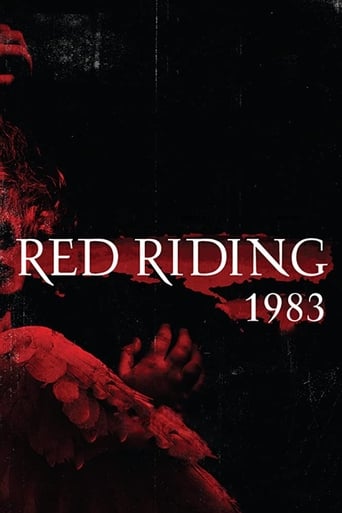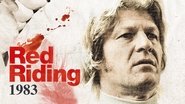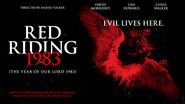NateWatchesCoolMovies
Sean Bean Week: Day 7The Red Riding Trilogy is one of the most dense, absolutely impenetrable pieces of work I've ever seen, let alone attempted to dissect with my clunky writing skills. It's also fairly horrifying, as it chronicles the tale of the Yorkshire Ripper, an elusive and mysterious serial child killer who terrorized this area of Britain through the late 70's and early 80's. Viler still are the strong implications that very powerful people, including the brass of the West Yorkshire police, made every disgusting attempt to cover up the crimes and protect the killer, who's murders included that of children. It's a brave move by UK's Channel 4 to openly make such notions obvious within their story, and commendable the level of patience, skill and strong ambition in the undertaking is quite the payoff, whilst simultaneously taking a toll on you for sitting through it. The sheer scope of it must be noted; it's separated into three feature length films, each vastly different in setting, character and tone, and each blessed with a different director. The filmmakers even went as far as to film the first, which is set in 1974, in 16mm, the second in 35mm being set in 1980 and the third makes a leap to high definition video and takes place in 1983. Such a progression of time is a dismal reflection of the sticky corruption which clings to societies, decaying them stealthily over years, and the few keen individuals who will not let the truth die as long as there is a glimmer of uncertainty. Now, if you asked me exactly what happens over the course of this trilogy, who is who, what has happened to which characters and who is guilty, I simply wouldn't be able to tell you. It's a deliberately fractured narrative told through the prism of dishonest, corrupt psyches and has no use for chronology either. Characters who you saw die in the first film show up in the subsequent ones, actors replace each other in certain roles, and there's just such a thick atmosphere of confusion and despair that in the 302 minute running time I was not able to make complete sense. I think this is a great tactic to help you realize that the film means to show the futile, cyclical nature of reality, as opposed to a traditionally structured story with a clear cut conclusion. Events spiral into each other with little rhyme or reason, until we feel somewhat lost, knowing full well that terrible events are unfolding in front of our eyes, events that are clouded and just out of our comprehensive grasp in a way that unsettles you and makes you feel as helpless as the few decent people trying to solve the case. One such person is an investigative reporter searching for the truth in the first film, played by Andrew Garfield. He stumbles dangerously close to answers which are promptly yanked away by the sinister forces of the Yorkshire police, brutalized and intimidated into submission. He comes close though, finding a lead in suspiciously sleazy real estate tycoon Sean Bean, who's clearly got ties to whatever is really going on. The level of willful corruption demonstrated by the police is sickening. "To the North, where we do what we want" bellows a chief, toasting dark secrets to a roomful of cop comrades who are no doubt just as involved as him. The kind of blunt, uncaring dedication to evil is the only way to explain such behaviour, because in the end it's their choice and they know what they're doing. Were these officers as vile as the film depicts in the real life incidents? Someone seems to think so. Who's to know? Probably no one ever at this point, a dreadful feeling which perpetuates the themes of hopelessness. The second film follows a nasty Police Chief (David Morrissey) who is bothered by old facts re emerging and seems to have a crisis of conscience. Or does he? The clichéd cinematic logline "no one is what they seem" has never been more pertinent than in these three films. It's gets to a point where you actually are anticipating every single person on screen to have some buried evil that will get upturned. A priest (Peter Mullan is superb) shows up in the second film only to be involved in dark turns of the third. Sean Bean's character and his legacy hover over everything like a black cloud. A mentally challenged young man is held for years under suspicion of being the Ripper. A disturbed abuse survivor (wild eyed Robert Sheehan) seeks retribution. A Scotland Yard Detective (Paddy Considine) nobly reaches for truth. Many other characters have conundrums of roles to play in a titanic cast that includes Cara Seymour, Mark Addy, Sean Harris, James Fox, Eddie Marsan, Shaun Dooley, Joseph Mawle and more. The process in which the story unfolds is almost Fincher - esque in its meticulous assembly, each character and plot turn a cog in a vast machine whose purpouse and ultimate function are indeed hard to grasp. I need to sit down and watch it at least two more times through before the cogs turn in a way that begins to make sense to me, and a measurable story unfolds. It's dark, dark stuff though, presenting humanity at its absolute worst, and in huge quantities too, nightmarish acts that go to huge levels of effort just to produce evil for.. well, it seems just for evil's sake, really. The cast and filmmakers craft wonderful work though, and despite the blackness there is a macabre, almost poetic allure to it, beauty in terror so to speak. It's rough, it's long, it's dense and it thoroughly bucks many a cinematic trend that let's you reside in your perceptive comfort zone, beckoning you forth with extreme narrative challenge, an unflinching gaze into the abyss no promise of catharsis at the end of the tunnel. There's nothing quite like it, I promise you.
bob the moo
For the previous two films in this trilogy I had my reservations even though I enjoyed the grim tone and the good performances from a host of recognizable faces. I think part of it was that it felt like maybe there wasn't much behind the atmosphere and grim faces but that this delivery worked in its favor? Perhaps but for sure in this final film the content is really rather exposed as not being up to as much as the critical praise would suggest and ultimately we have a rather unsatisfying conclusion which retrospectively hurts the other films as well.Where the films started out with corruption lurking behind murders, they generally were just about kept believable within the real world context that the films tried to retain. In this final one though it really feels like it gets too big and too serious and I found it hard to get into because it all became such a fiction. The plot here jumps back and forth in time but does so without any warning or signal that it will do so, which did throw me for a few seconds as I tried to figure out why characters who had died seemed to be up and about showing no signs of death. This occurs to fill in details and information to help us with the current plot (a lawyer investigates the original swan-wing killing while a policeman reaches the end of his moral tether) however there is a problem with this structure. The problem is that it feels like we were deliberately kept in the dark – I understand some of it is a mystery which is being revealed but it was known from the first film who did the killings and who was involved in the cover-up and why they did it, so the flashback don't "reveal" so much as flesh out and they do it in a way that made me wonder why such scenes were not in it earlier since I was there at the time.These things distracted me from the biggest annoyance which is that this film connects to the first one but has very little with the second film. The reason I rushed into seeing this third one was the basis of the revelations and twists at the end of the second film and it was disappointing to see that basically the second film would easily have been dropped since it doesn't add a great deal in the middle when viewed in context of the complete trilogy. The irony is that the third film is significantly weaker than the second one. The time-jumping is a little off-balancing although it does work in filling in the character of Maurice at least but I really didn't like the use of the medium as a major plot device – it really clashes with the grim realism thing it had been doing and just seems lazy as a piece of writing. The connections all coming together don't satisfy as they should either – again the bigger they get the less they work and the network is too tight to convince.The performances and the grim atmosphere continue to cover for the weaknesses. Addy is good because at least his performance differs from the majority since he is more innocent and wide-eyed than the grim lot. Morrissey plays the other extreme well but mostly it is dead-eyed tiredness that he does, albeit well. Support from Clarke, Carter and others is good but in some cases they have little to work with in their characters (Mullan in particular). It is a shame then, but this film doesn't come together and it is additionally disappointing since this third film needed to bring the other two to a close and make the trilogy strong. It doesn't do this and instead it feels like the material reaches too far and unravels as it approaches an unsatisfyingly convenient and delivered conclusion. I quite enjoyed the previous two films even though I didn't see what all the critics and IMDbers were raving about – in the light of the third I am even more mystified about why this trilogy got such universal adoration.
Robyn Nesbitt (nesfilmreviews)
The seemingly untouchable, corrupt West Yorkshire police, and the true evil mastermind behind the child abductions and murders of the last 14 years, can't resist doing it again. "Red Riding: 1983" sets the story that another young girl has vanished from the same area, nine years earlier. "Red Riding: 1983" cycles back to the terrible events set in motion in "Red Riding: 1974", when a series of young girls went missing and a mentally retarded man, Michael Myshkin (Mays), was wrongfully convicted for the crime. Detective Inspector Maurice Jobson (Morrissey), a regular if mostly background character in the first two films, becomes our first focal point here as a man deeply wrecked by his complicity in the Yorkshire Constabulary's general lawlessness. In 1983, another young girl disappears, and Jobson decides to do some actual police work--and reopening several old cases his colleagues would prefer to keep closed--and sniffing around the likes of series constant Rev. Lawes (Mullan, with the omniscience and eerie stillness of a very dark angel). Simultaneously, in the trilogy's first dual narrative, another lead emerges in the form of John Piggott (Addy), a sad-sack solicitor and Yorkshire native who reluctantly agrees to file an appeal on behalf of Myshkin. Piggott marks the trilogy's most uncomplicated hero.It may come as a surprise that the ending of "Red Riding: 1983" adds a dose of hope to its brackish main course. "Red Riding: 1983" provides a fitting conclusion to a whole that is, in some ways, greater than the sum of its parts." Red Riding" is an effective crime thriller, but it's an even more striking drama about the dark parts of the human soul and man's capacity for inhumanity. The third movie represents the middle ground between the promising-but-uneven" Red Riding: 1974" and its sequel, the shocking and haunting "Red Riding:1980." This time around, there's less in the way of a stand- alone narrative as screenwriter Tony Grisoni, working from the novel by David Peace, stitches closed various plot holes. The finale doesn't answer all of our question, but it provides a sense of closure and clears up a number of nagging questions left over from the previous two segments.What we can take away from all of this is not just an investigation into a series of child murders. This is an in-depth character study of three (or four) main protagonists--as they slowly unfold a ring of corruption surrounding an era of a very specific locale of the UK. As things get "hairy" within each of our main characters' worlds, rather than dig deeper into the case, they instead spend three quarters of the running time of each film digging deeper into their own psych--and begin to like what they see in themselves less and less.
Rodrigo Amaro
Finally something really, really interesting came out of one of the films of this "Red Riding" series. Even dwelling on some known areas the plot in this third installment gives some surprises, some tension and some excitement the other flicks didn't have or struggled to make us interested. Finally connected the stories, revealed the answers for the mysteries and concluded beautifully. But "Red Riding Hood - In the Year of Our Lord 1983" wouldn't be a film of the franchise without confusing us a little bit. My problem with these "confusion" is that all of that is a mask to sound and look complicated but when you dig deep into the characters and situations you'll actually find an easier film to connect than most serial killer films really are. Without the journalist Eddie Dunford (only through one flashback) and the investigator of the previous film, this "Red Riding" has two main characters trying to solve the case involving the disappearance of little girls: it brings back detective Maurice Jobson (David Morrissey) and introduces John Piggott (Mark Addy), a lawyer representing the wrongfully accused of being the killer of some of these girls. When Piggott's on scene the movie develops very well but when Jobson segment is presented sometimes it works (now he's quite soft, not even dealing well with torture during interrogations of suspects) other times it doesn't (some of his dramatic moments aren't good enough to make you care about him, but it is most for the fact I can't stand the actor behind the role, an bad imitation of Liam Neeson). So here we have two goals: to find the real killer and the reasons behind it, and to release innocent people from jail. Again it's a movie about the crimes without the need of showing how they happen, but this time we have a more violent film than the two others (specially police's brutality and the final revelation behind the crimes).This one was far more intelligent than the previous film, it really created thrilling sequences, very surprising and I enjoyed a lot. It was less tiring than 1974 and 1980 parts. Mark Addy was brilliant here in a dramatic role, playing this dedicate lawyer. Compared with what Hollywood throws every single year this and the other "Red Riding" are precious pictures with great quality. It's a decent trilogy. 8/10






